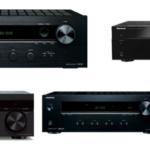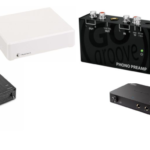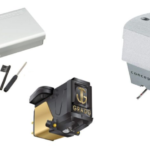Last Updated on March 8, 2023
When it comes to playing music on your turntable, there are several configurations that you can play around with. There are the preamps, the phonos, as well as receivers. Heck, with all these terminologies, it can be pretty confusing. What we know is that some audiophiles prefer to get the all-in-one solution that the receiver provides as compared to getting individual components as the former can be cheaper and yet they can produce good quality sound too. When you connect the turntable to a receiver, it will actually help to deliver the sounds out from your turntable. If you are looking for the best receiver for turntables, you might be awed by the many choices that you have online. Let us take a closer look.
What to Look for When Buying a Receiver for Turntable Under $500?
Before diving into the details of the best receiver for turntable under $500, it is important to understand the factors you should consider when buying one.
- Power Output
The power output of a receiver is measured in watts. Generally, the higher the power output, the better the sound quality. However, the power output should match the wattage of your turntable’s cartridge to avoid damaging it. For a turntable with a cartridge of 5 watts or less, a power output of 25 watts per channel is sufficient.
- Compatibility
Make sure the receiver you choose is compatible with your turntable. Check the inputs and outputs of the receiver to ensure they match the connections on your turntable. Most turntables have a built-in preamp, but if your turntable does not have one, make sure the receiver you choose has a phono preamp.
- Sound Quality
The sound quality of a receiver is crucial for an enjoyable listening experience. Look for receivers that have a low Total Harmonic Distortion (THD) and Signal-to-Noise Ratio (SNR). THD measures the distortion in the audio signal, and a lower THD means better sound quality. SNR measures the ratio of the audio signal to background noise, and a higher SNR means clearer sound.
- Features
Consider the features you need in a receiver, such as Bluetooth connectivity, Wi-Fi, built-in streaming services, and support for high-resolution audio formats. Keep in mind that the more features a receiver has, the higher the price.
- Brand Reputation
Choose a brand with a good reputation for producing high-quality receivers. Some reputable brands for turntable receivers include Yamaha, Onkyo, Denon, and Marantz.
Best Receiver For Turntable Under $500
While the task is daunting to review and choose the best receiver that will be suitable for your turntable as well as your needs, we have done the hard work for you. We are fortunate that we managed to get a hold of some of the receivers for a good testing. While some of the receivers can be expensive, there are still some that will not burst your budget. We have specifically decided to cap the maximum price to $500 as we are trying to find receivers that are not too expensive.
#1: Yamaha RX-V683BL
#2: Yamaha R-N303BL
#3: Onkyo TX-8020
#4: Pioneer VSX-832
#5: Sony STRDN1080
#6: Denon AVR-S510BT
Yamaha RX-V683BL
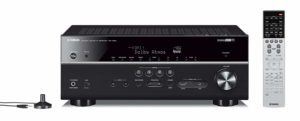
The Yamaha RX-V683BL is an all-inclusive receiver that works well with any external audio devices. From your Blueray system to your turntable, you can control all of those just by using this receiver itself.
What we love about this receiver, other than its sleek design, is the ability for the receiver to receive signals from your turntable and project it out via the speakers or even via the Subwoofer (but this can be optional). It also provides a 7.2 channel surround Ultra HD surround sound that features the Dolby Atmos as well as the DTS:X surround sound that is usually only available in the cinemas!
There is the ability to cast music to up to 9 devices in the same house. You can connect to the receiver via Wi-Fi, Bluetooth or even with your Apple devices via the AirPlay system.
When we tested the Yamaha RX-V683BL , we realize that the sound is superb. It is incredibly smooth and clear, and you could really differentiate the different sounds that are coming out from the system itself.
Here are some of the key stats of the Yamaha RX-V683BL.
| Channel | 7.2 |
| Maximum Effective Output Power | 150W |
| Rated Output Power | 90W |
| 4K Ultra HD Pass-through and upscaling | Yes |
| HDMI Input/Output | 6 / 1 (HDCP2.2, HDR10 / Dolby Vision / HLG and BT.2020 compatible) |
| Connection Options | Wi-Fi, Bluetooth |
| Surround sound | Dolby Atmos and DTS:X |
With a good price point as well as some features that you will die for, the Yamaha RX-V683BL might simply be the best choice for a receiver that you can use with your turntable.
Yamaha R-N303BL
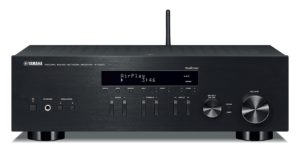
If you are looking for something that is simple yet have the phono input that works well with your turntable, then perhaps the Yamaha R-N303BL Stereo Receiver will be a good choice for you. It is pretty similar to the RX-V683BL , but without the ability to play music in the standards that the RX-V683BL could provide.
We took the Yamaha R-N303D Hi-Fi receiver out for testing, and the sound generated, while not as awesome as the RX-V683BL, is still more than adequate for the average listener, especially if you are looking into pairing it with your turntable. Indeed, for everyday use, perhaps this budget turntable will serve you well.
Here are some of the key stats of the Yamaha RX-V683BL.
| Channel | Stereo |
| Maximum Effective Output Power | 100w |
| 4K Ultra HD Pass-through and upscaling | No |
| HDMI Input/Output | Yes |
| Connection Options | Wi-Fi, Bluetooth |
| Surround sound | No |
If you are on a tight budget and still wish for a good receiver, you can opt for the Yamaha R-N303BL Stereo Receiver. It is simple yet sophisticated enough to project quality sound from your turntable.
Onkyo TX-8020 2 channel Stereo Receiver
The 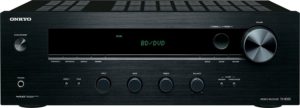 Onkyo T/X-8020 is another good receiver with phono inputs that you can use with your turntable. While it does not have the 7.1 surround sound, it does have the stereo outputs that will be more than adequate in providing the sound that your turntable could produce.
Onkyo T/X-8020 is another good receiver with phono inputs that you can use with your turntable. While it does not have the 7.1 surround sound, it does have the stereo outputs that will be more than adequate in providing the sound that your turntable could produce.
The controls on the Onkyo T/X-8020 proves to be adequate enough for most users to operate this turntable compatible receiver. While you can play on the radio due to the WRAT that is incorporated into this receiver, there is no option to connect via wireless devices.
Here are some of the key stats of the Onkyo T/X-8020.
| Channel | 1 Channel stereo |
| Maximum Effective Output Power | 50W |
| 4K Ultra HD Pass-through and upscaling | No |
| HDMI Input/Output | No |
| Connection Options | AirPlay Dock |
| Surround sound | No |
While most features might be missing, it still can produce sounds that rivals most other receivers of the same profile. Having tested it with a Dual 505-4 Turntable, we were positively surprised at how well the sound was being re-produced by the receiver. The Onkyo T/X-8020 proves to be a good purchase by people on a shoe-string budget.
Pioneer VSX-832
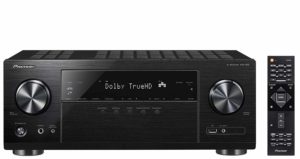 Moving on from the previous few stereo receivers for turntables, we have the Pioneer VSX-832 which proves to be able to provide a surround sound when u connect it via the phono input to your turntable.
Moving on from the previous few stereo receivers for turntables, we have the Pioneer VSX-832 which proves to be able to provide a surround sound when u connect it via the phono input to your turntable.
It does have the 5.1 channel surround sound that is the DTS:X and Dolby Atmos systems that you should be familiar with already. The surround sound does mean that you can literally hear sounds coming from the rear of the room, hence giving you a 3D sound that will allow you to immerse yourself in quality music without needing to break the bank for an expensive home set up!
Here are some of the key stats of the Pioneer VSX-832.
| Channel | 5.1 |
| Maximum Effective Output Power | 165W |
| Rated Output Power | 80W |
| 4K Ultra HD Pass-through and upscaling | Yes |
| HDMI Input/Output | 4K, BT.2020, and HDCP 2.2, |
| Connection Options | Wi-Fi, Chromecast, Bluetooth |
| Surround sound | Dolby Atmos and DTS:X |
While it might be a little pricier than the overage receivers, the Pioneer VSX-832 will be a good choice for many, especially with its capability to connect to your turntable via the phono input as well as its ability to reproduce sounds with a 3D effect. It is a gem that will surely continue to wow you throughout your listening experience.
Sony STRDN1080
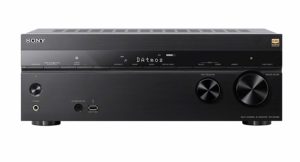 When choosing a good receiver with phono input for turntable, we came across the Sony STRDN1080. Often touted as the best AV receiver under 1000, we just had to loan the Sony STRDN1080 from the local store for a testing. It is certainly one of the best decisions that we have made, given that the AV receiver for turntable is able to produce sounds that we have never imagine.
When choosing a good receiver with phono input for turntable, we came across the Sony STRDN1080. Often touted as the best AV receiver under 1000, we just had to loan the Sony STRDN1080 from the local store for a testing. It is certainly one of the best decisions that we have made, given that the AV receiver for turntable is able to produce sounds that we have never imagine.
A true 7.2 channel sound system, the Sony STRDN1080 is a top favourite for true audiophiles that wishes for a 7.2 surround system that can produce sounds that envelops the entire room. Together with the ability to channel music to various zones, you are quite spoilt for choice. It does have various connections options, ranging from your regular Bluetooth, Wi-Fi to your AirPlay solutions, you can play various music from various sources at the same time!
Here are some of the specs that will be able to interest most audiophiles in choose the Sony STRDN1080.
| Channel | 7.2 |
| Maximum Effective Output Power | 165W x 7 |
| Rated Output Power | 90W |
| 4K Ultra HD Pass-through and upscaling | Yes |
| HDMI Input/Output | 6 in/2 out w/ HDCP 2.2 support |
| Connection Options | Wi-Fi, Bluetooth, Chromecast, AirPlay |
| Surround sound | Dolby Atmos, DTS:X, and rear Phantom surround |
While it may be a little pricey, the Sony STRDN1080 is still a top choice for me. When it comes to the best all in one stereo system with turntable, nothing comes closer than this when you compare the features as well as the price point. What totally sold us was the Phantom rear surround sound, which is unique to this receiver.
Denon AVR-S510BT
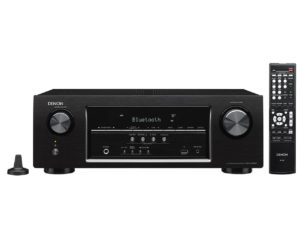
Should you wish to pair your Denon DP 29F Turntable to a receiver, then the best choice might be the Denon AVR-S510BT. It is well suited for your set up, given that the mechanism being the design are pretty much the same.
When it comes to combining value as well as performance, the Denon AVR-S510BT is able to rival many of the most expensive counterparts. While it is able to delivery sonic fidelity to your ears, it can also help to provide a true surround sound that mimics that from the usual theatre.
Following will be the specs of the Denon AVR-S510BT that might be crucial for you to make the decision to purchase it.
| Channel | 5.2 |
| Maximum Effective Output Power | 140W |
| 4K Ultra HD Pass-through and upscaling | Yes |
| HDMI Input/Output | 3 designated HDMI inputs and full HDCP 2.2 support |
| Connection Options | Wi-Fi, Bluetooth |
| Surround sound | Dolby Atmos, DTS:X |
We love the Denon AVR-S510BT because of its simplicity as well as its ability to produce quality sound, all at a fraction of a price. If you are looking for a brand name receiver that will work well for your turntable then the AVR-S510BT will suit your needs.
How Do You Connect The Turntable To A Receiver
Before you decide on purchasing a receiver for your turntable, you might first need to decide if you really need one, or if you know how to connect the turntable to a receiver. The key actually lies in the phono preamp, as it is the main component that helps to converts the electric signals from the turntable to become sound.
Phono preamps can be found in three different areas. It can either be found in your turntable itself (some turntables have built-in phono preamps), or it can be found in the receiver. Since it can be found in devices itself, it can also come in a stand-alone preamp.
So, the connection of the turntable to the preamp really depends on the type of turntable itself (whether or not you have in-built phono preamp), the type of receiver that you purchased as well as if you have decided to purchase an external standalone preamp.
- Option 1: Existing turntable, without preamp, and a receiver with phono preamp.
If this is the case, then it will be simple for you already. All you need to do is to connect the receiver’s phono input to the turntable’s signal output. This will allow the receiver to receive the signals from the turntable and amplify the sound out to its various channels.
This is the simplest option, as you wouldn’t need to figure out which cable goes into which port. The only thing that you will need to know is the position of the relevant input and output channels.
- Option 2: Existing turntable with preamp, and a receiver without phono preamp.’
This scenario is highly unlikely, given that we have reviewed receivers with phono preamps. However, if you have accidentally chosen one that does not have a preamp, you can still connect it to your turntable, assuming that the phono preamp is there. All you need to do is to put the cable from the turntable audio signal output into the receiver’s analogue audio input. Sometimes, it can also be labelled as the auxiliary input.
- Option 3: Both turntables and receiver have the phono preamp.
If this is the case, you should follow the steps given in option 2. This is actually pretty straightforward, as it doesn’t make any sense to connect a phono audio output to a phono audio input.
What features should I look for in a receiver for my turntable?
As mentioned earlier, when looking for a receiver for your turntable, there are several features you should consider. First, you’ll want to look for a receiver with a built-in phono preamp, as this will allow you to connect your turntable directly to the receiver without needing a separate preamp. You should also consider the number of inputs and outputs the receiver has, as well as the type of connections they offer. Look for a receiver with multiple analog inputs, as well as digital inputs like HDMI or USB if you plan on connecting other devices like a TV or computer. You’ll also want to make sure the receiver has enough power to drive your speakers, so check the wattage rating and make sure it matches the impedance of your speakers.
Can I use any receiver with my turntable?
Technically, yes, you can use any receiver with your turntable as long as it has a phono input or a built-in phono preamp. However, not all receivers are created equal when it comes to the quality of their phono preamps, and using a low-quality preamp can result in poor sound quality. If your receiver doesn’t have a phono input or preamp, you can still use a separate external preamp, but this will add an additional component to your setup.
What is the best type of receiver for a turntable – analog or digital?
When it comes to selecting a receiver for your turntable, there is no clear answer as to whether analog or digital is better. Both types have their advantages and disadvantages, and the best option ultimately depends on your personal preference and listening habits.
Analog receivers typically offer a warmer, more natural sound that some people prefer for vinyl playback. They also tend to be simpler and more affordable than their digital counterparts. However, analog receivers may have more limited features and connectivity options compared to digital receivers.
On the other hand, digital receivers offer a wider range of features and connectivity options, such as Bluetooth, Wi-Fi, and multi-room audio. They also tend to be more precise and accurate in their sound reproduction, which may be preferable for some listeners. However, some people find digital sound to be colder and less natural than analog sound. Ultimately, the best choice is a matter of personal preference and budget. It’s worth listening to both types of receivers and determining which one sounds best to you.
Should I Get A Receiver Or An Amplifier
When it comes to choosing either the receiver or an amplifier for your home set up system, there are a few criteria that you might need to be mindful of. You must be puzzled at the need to make the choice, right? This is because while the receiver is an all-in-one system, the amplifier does only one thing, which is to amplify sound signals. If you want to get a tuner or other devices, then you might have to purchase them separately, which will obviously be additional costs to you. As such, when it comes to cost-conscious folks, they will usually choose to purchase a receiver.
Conclusion
Choosing the best receiver for turntable under $500 can be a challenging task. However, with the options mentioned above, you can rest assured that you’re getting a good quality product that will enhance your listening experience. Whether you choose any of the recommended receivers, you’ll be able to enjoy high-quality sound at an affordable price. So go ahead, invest in a good quality receiver, and experience the best audio quality that you truly deserve!


